This is a Canon EF 35mm single lens reflex camera made by Canon Inc of Japan between the years of 1973 and 1978. It used Canon’s FD lens mount and was their first interchangeable lens SLR with in-body shutter priority automatic exposure. It is unique among FD mount SLRs in that it’s the only one that uses a Copal Square metal blade shutter. The shutter is mechanical at all speeds starting at 1/2 second and faster, but from 1 second and beyond the shutter is all electric, allowing for AE shutter speeds as long as 30 seconds. The camera was very well built, and was very expensive when new, costing a mere $90 less than their top of the line F-1. It remains one of Canon’s most well built and highly capable manual focus SLRs ever made.
Film Type: 135 (35mm)
Lenses: 50mm f/1.8 + others
Lens Mount: Canon FD Breech / Bayonet Mount
Focus: Varies by Lens
Viewfinder: Fixed SLR Pentaprism with visible shutter speed and aperture readouts
Shutter: Mechanical / Electrical Copal Square vertically traveling metal blade
Speeds: B, 30 – 1/1000 seconds (30 – 1 second electronic, 1/2 – 1/1000 mechanical)
Exposure Meter: TTL Center Weighted SPD meter with Shutter Priority Auto Exposure
Battery: 2 x 1.35v PX625 Mercury Batteries
Flash Mount: Hotshoe and PC MX Sync
Manual: http://www.cameramanuals.org/canon_pdf/canon_ef.pdf
History
Today, Canon is one of the largest electronics companies in the world. It is the 10th largest company in Japan and is a primary member of the Japanese stock exchange. Most everyone on the planet has at one time in their lives used or touched a Canon product, whether it was a camera, scanner, copier, or printer. Despite their massive success today, Canon was a relative late comer to the Japanese camera industry in the first half of the 20th century.
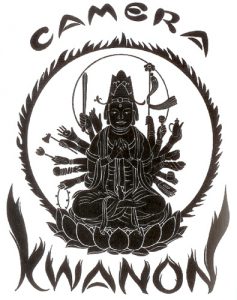
Canon was founded in 1933 as Seiki Kogaku K.K. or Precision Optical Industries in English by a modest repair technician named Goro Yoshida, Yoshida’s brother-in-law Saburo Uchida, and a third man named Takeo Maeda. Together, the three men set a goal to build Japan’s first compact 35mm camera. Their first prototype was called the Kwanon, named after the Buddhist Goddess of Mercy. It was heavily inspired by the Leitz Leica II rangefinder.
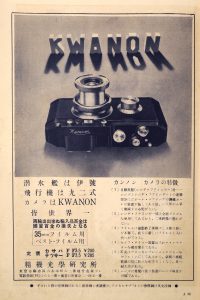
The Kwanon was shown in wooden and illustration form in various Japanese publications at the time, but according to Canon Global’s company history page, none were known to actually have been built. Goro Yoshida had at one time claimed to have built 10 Kwanon models, but this information has been doubted as none have ever been seen. There is at least one camera called a Kwanon Model D that is often cited as a real Kwanon, but it was later found to be a rebadged Leica II that was not actually built by Seiki Kogaku. Most online sources with information about the Kwanon camera, show this same Kwanon Model D.
Although Seiki Kogaku had the necessary technology and expertise to design the body and shutter to German specifications, they lacked expertise in optics design, so they had to call upon Nippon Kogaku, who was a highly successful Japanese optics company. Nippon Kogaku had been around since 1917 and built many optics products for the Japanese military. After World War II, Nippon Kogku would design their first camera called the Nikon. Nippon Kogaku would later rename itself to Nikon and become one of Seiki Kogaku’s biggest competitors, but they started out as partners.
The Kwanon was never sold to the public, and by the time it was ready for civilian consumption in 1936, it’s name had changed to the Hansa (or Standard) Canon. In manufacturing the Hansa Canon, Seiki Kogaku was responsible for the main body including the focal-plane-shutter, the rangefinder cover, and the assembly of the camera body. Nippon Kogaku was responsible for the lens, the lens mount, the optical system of viewfinder, and the rangefinder mechanism.
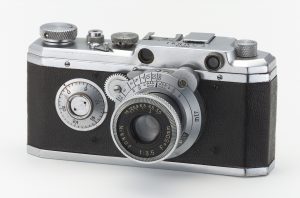
In the early 1940s, the company made a variety of optical products such as X-ray lenses and lenses for television cameras. By the end of World War II, Seiki Kogaku changed its name to Canon Camera Co., Inc which was in line with other Japanese companies who adopted more English sounding names in an effort to appeal to Western countries who were reluctant to purchase goods made by Japanese companies.
With its beginnings making copies of Leica inspired rangefinders, Canon continued their focus on rangefinders into the 1950s. Although originally considered a clone of the Leica, Canon rangefinders adopted more and more proprietary features differentiating them from their German competitors. Starting with the Canon VI in 1956, the Canon P in 1959 and the Canon 7 series in 1961, Canon’s reputation as a world class maker of top of the line rangefinder cameras became undisputed. While the Germans were still considered the best, they no longer stood alone, and Canon rangefinders could compete head to head with the best of what Germany had to offer.
By the mid 1950s, more and more Japanese companies were turning their attention to SLR cameras, which up until that time were exclusively made by German companies. The first Japanese SLRs were made in the mid 50s by Asahi (Pentax), Orion (Miranda), and Topcon with Nikon and Canon following later with their SLRs in 1959. Unlike Nikon however, Canon would continue making rangefinders and SLR cameras throughout the 1960s and 70s whereas Nikon pretty much shifted all of its focus to the SLR design and stopped making rangefinders in the early 1960s.
The earliest Canon SLRs were known as the Canonflex series and its associated variants are now known as the Canon R-Series. These early SLR cameras lacked many modern features and had rudimentary designs. Although collectible by film historians, they aren’t sought after for their performance.
In 1964, Canon released a new line of SLRs starting with the Canon FX, whcih featured a new lens mount known as the FL mount. This new mount would set the groundwork for future Canon lens mounts for the next couple of decades.
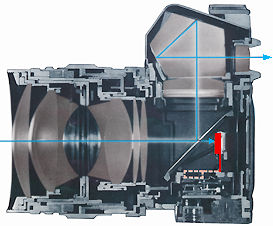
In 1965, the Pellix camera was introduced which attempted to solve one of the early challenges of TTL metering by incorporating a fixed semi-transparent mirror that allowed some of the light to pass through to the film plane, while redirecting the rest of the light up into the viewfinder. During exposure metering, a movable CdS sensor (represented in red in the image to the left) would swing up in front of the film plane for metering, and then swing back down when capturing an image.
Although the Pellix design did work, it came at the expense of viewfinder brightness. These Pellix cameras have darker viewfinders since only some of the light is reflected by the mirror making them very difficult to shoot with in low light. In addition, the lack of a moving mirror made little to no improvements on quieting the sound of the camera compared to other SLRs of the day.
Only a year after the Pellix was released, Canon released the FT which was their first true success with a 35mm SLR. The FT camera had a normal quick return mirror like most other SLRs, and had a large metal design body with a reliable shutter. The excellent build quality of the FT cameras and their growing reputation as an innovative company who made excellent lenses catapulted them near the top of the industry. The FT would be revised over the next few years as the FT QL, FX, FP, FTb, and FTbn.
By the end of the 1960s, rangefinder cameras were losing popularity with serious photographers who favored SLRs. The only player in the high end SLR market was Nikon with their F-series. In 1971, Canon released the Canon F-1 which was based off the FT, but had a selection of interchangeable parts, accessories, and lenses. The F-1 introduced a new FD lens mount which allowed open aperture metering (as opposed to stop down metering like on the FL mount) and was backwards compatible with older lenses. The F-1 was an immediate success and in some ways was the nail in the coffin for Canon’s rangefinder business. Although the company was still making entry level Canonet rangefinders at this time, the company continued to shift towards an SLR only company.
The F-1 was a huge success, but it was extremely expensive and was aimed at the professional photographer. The advanced amateur market was clamoring for a more advanced, but easier to use camera. Konica had previously released their successful Auto-Reflex T-series which had shutter priority auto exposure in a full bodied, mechanical SLR camera. Perhaps due to market pressure to compete with Konica, Canon would release a new model called the Canon EF in 1973 which resembled the body of the F-1 but with an all new electronically controlled shutter and support for Auto Exposure.
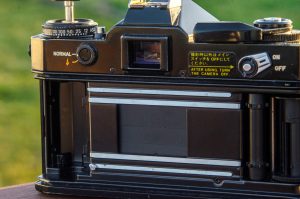
The electronic shutter used in the Canon EF was a both a first and a last for Canon, the Copal Square vertically traveling electronic shutter. Every Canon SLR up until this point used either horizontally traveling metal or cloth shutters. The cameras that would follow the EF, like the entire Canon A-series would revert back to horizontally traveling shutters. It would not be until the Canon T50 from 1983 that another vertically traveling metal blade shutter would be used in a Canon SLR.
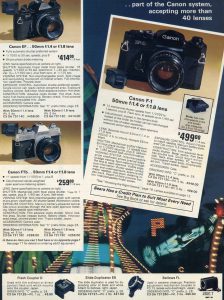
Unlike other Canon SLRs with electronic shutters, the EF could be used with a dead battery. The way the Copal shutter was designed was that speeds from 1/2 second all the way to 1/1000 second were mechanical. The electronic part of the shutter would not be used unless a shutter speed of 1 second or longer was needed, so with a dead battery, these extremely slow speeds were not usable, but that’s hardly a problem for most people.
In addition to a new shutter and auto exposure, the EF was loaded with many other useful features. It was positioned below the F-1, but above the FTb in Canon’s lineup. See the image to the left of a Sears catalog from 1976, which lists the F-1 with 50mm f/1.4 lens for $549.00. The EF and FTb with the same lens are listed at $459.00 and $299.00 respectively. When adjusted for inflation, those prices are $2350, $1965, and $1280 today. Like the F-1, the EF is only available in black, which was the preferred color for professional photographers. The lack of a silver model and the EF’s high price, confirms it was targeted primarily at the advanced amateur or professional photographer.
The Canon EF was in production for a little over 4 years making it one of Canon’s shorter lived models. I wouldn’t call it a failure however, as I am sure the rapid advancement of many of the EF’s best features in smaller, and less expensive models like the AE-1 and it’s competitors, led to it’s discontinuation. The EF represented an uncommon combination of the large mechanical SLRs of the 60s and early 70s, but with advanced electronic features of the late 70s and 80s. If you like auto exposure, but not plastic, the Canon EF is for you.
Below is a sneak peek of the Canon EF from the January 1974 issue of Modern Photography, giving a short run down of the camera’s highlights.
A comment about the name “EF” is that those same two letters became the name of Canon’s auto focus lens mount in 1986 when they released the EOS series of cameras. Since then, all auto focus Canon lenses are called “EF” lenses, which can make finding information about the Canon EF camera difficult, as searches for “Canon” and “EF” more commonly come back with lens results, rather than this camera. Keep that in mind if you are trying to find one for sale.
Today, the Canon EF is remembered by photographers active in the 1970s as a state of the art and expensive camera. It was out of the price range of most amateurs and because it was only in production for a little over 4 years, it does not share the same level of demand as later Canon SLRs, even though it shares many of the same features as those later Canons. Prices on the used market are all over the place. Sometimes they’ll go for $20 – $30 in untested condition, but then you’ll see a nice one go for a couple hundred dollars.
My Thoughts
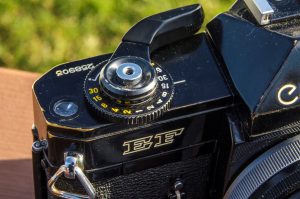
Millions of Canon SLRs have been made over the years and their success has made them as one of the most popular camera makers of all time. The Canon AE-1 was an extremely popular model that was in high demand for nearly a decade, and still remains a popular choice today. I’ve owned many Canon SLRs in my time collecting, and for one reason or another, other than the AV-1, they never really grabbed me. I always attributed it to the fact that electronic Canons were always dependent on a battery to work. This was in contrast to electronic Nikon SLRs of the same era that usually were still usable with a dead battery. Another reason was that for the Canon SLRs with Auto Exposure, they almost always used Shutter Priority AE, instead of Aperture Priority AE like everyone else. The only exceptions being the AV-1 and AL-1, both of which were not hugely popular models.
I knew Canon SLRs were generally well made and capable of excellent images, but there just gets to be a point when you collect and shoot cameras where you lose interest in buying into yet another system camera with it’s own unique lens mount so for that reason, I rarely paid any attention to classic Canon SLRs.
One day, my friend and fellow collector Adam Paul from quirkyguywithacamera made a quick post about an all black Canon FTb that he had picked up at Goodwill. I became a bit envious as the good looks of the all black and large bodied FTb prompted me to consider that maybe I should take a second look at Canon’s older, all metal SLRs. After all, the build quality and reputation of late 60s/early 70s Canon SLRs were on par with those from Nikon, so why not give a model like the FTb, TL, or TX a shot? I didn’t have a specific preference of which one, but I began looking for a suitable full sized Canon SLR from that era. It was during this search that I first read about the Canon EF.
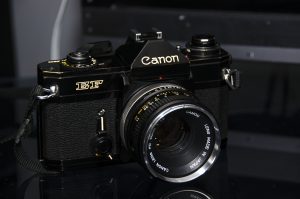
I was intrigued. The Canon EF quickly revealed itself to not be like these other Canons. Sure, it still had Shutter Priority AE, but the rest of it’s specs sounded a LOT like the Nikomat ELW which I have reviewed here. The ELW used the same Copal Square shutter and works without a battery, just like the EF. Considering the two cameras were available at the same time, the Canon EF would have been a direct competitor to the ELW, and I loved the ELW, so why not give the EF a shot?
It didn’t take me long to find a nice looking Canon EF at an attractive price and as an added bonus, it came with a chrome nose Canon 50/1.8 lens already mounted. Upon receiving the camera, I was pleased to see that everything worked as expected. It showed just the right amount of use to reveal a beautiful patina to the black body, showing hints of brassing around the edges. I gave the camera a gentle wipe down, installed two fresh PX625 batteries, replaced the light seals, and went shooting.
Like the Nikomat ELW, the Canon EF’s size and weight is from an earlier mentality of camera design where bigger is better. While Olympus and Pentax were already releasing sleek and compact SLRs, Canon was still a couple of years away from their use of plastic in compact SLRs. The EF is a heavy camera, but it never borders on too heavy. You’d definitely notice it hanging from your neck on an all day adventure, but it’s not cumbersome.
The advantage of a large metal body is that the camera has great balance and it fits nicely into my hands. Children, or people with smaller hands might find the EF to be uncomfortable, but for me, I found all of the camera’s controls to be easy to reach. During my time with the EF, I kept the 50/1.8 lens on it the entire time, but my experience with similar metal bodied cameras suggested that had I used a heavier telephoto or zoom lens, the weight of the camera would have helped balance out a heavier lens. Many of the smaller plastic cameras that would be released in the years to come have a tendency to become front heavy when mounted to a larger lens.
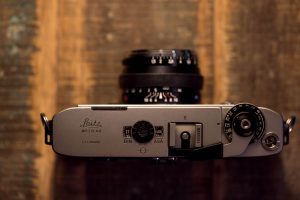
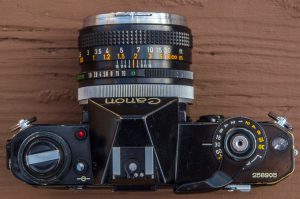
The ergonomics of the EF are pretty standard compared to other 60s and early 70s SLRs with one exception, which is the shutter speed selector. Unlike most SLRs where this selector is around the collar of the lens or on a dial on the top plate of the camera, the Canon EF has an oversized shutter selector ring that extends beyond the front edge of the top plate. This allows you to quickly change shutter speeds with your right index finger without having to take the camera away from your eye. This is almost identical to the setup on the Leica M5 where the oversized shutter speed selector extends beyond the front edge of the top plate. Whether someone on the EF’s design team was inspired by the M5, or if this is just a coincidence is anyone’s guess. In either case, it’s a really nice touch.
The benefit to this is not immediately apparent until the first time you put the camera to your eye. While it might not seem like this should be a big deal, it is. It addresses one of the major complaints I have with Shutter Priority AE cameras. Compared to a camera like the Canon AE-1, you have to fiddle around with this dial blindly when the camera is to your eye. I have always found it necessary that when shooting with an AE-1 to lower the camera from my eye to re-position my right hand when changing speeds. I am sure that with repetition, a photographer would get used to the location of the shutter speed dial on other Canon AE SLRs, but with the EF, you don’t have to. The very first time you pick one up, you’ll naturally be changing shutter speeds on the fly.
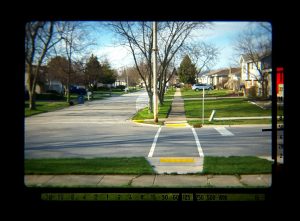
The viewfinder has an aperture scale along the right side and a shutter speed scale along the bottom. The exposure meter indicates an appropriate f-stop in the aperture scale in both manual and AE modes, however when shooting in manual mode, there is no indication of your chosen aperture value within the viewfinder. The shutter speed scale shows all shutter speeds from 30 seconds to 1/1000 plus Bulb, in a fixed position. A two prong indicator moves along the bottom as you change shutter speeds. When used in AE mode, you can very easily see which shutter speeds you have selected without having to remove the camera from your eye. I’ll say it again, I love the implementation of this scale and the shutter speed selector on the Canon EF. I do not understand why they did not continue this design on later Canon SLRs as I think it would have made adoption of shutter priority AE much more prevalent.
The viewfinder itself is bright and easy to use. Early copies of the EF like mine have a microprism dot surrounded by a ground glass circle. At some point in 1975, this was changed to have a split image focus aide in the center, surrounded by a microprism circle. According to this post on photo.net, this change occurred around serial number 280xxx. Unfortunately, the focus screen was not designed to be easily interchangeable, but if someone were so inclined, it is possible disassemble the camera to change one out. My example, with serial number 258905 has only the microprism circle.
When it was first released, the EF wasn’t an inexpensive camera. It was positioned immediately below Canon’s professional level F-1, only lacking an interchangeable viewfinder or the ability to be connected to a motor drive. Like the F-1 however, it has some useful features like mirror lockup, a 10 second self timer, depth of field preview, and the ability to intentionally double expose images.
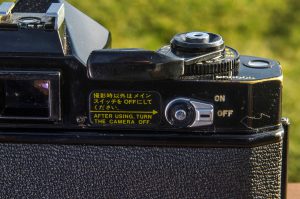
Double exposures are accomplished by holding in the small chrome button in the center of the power switch on the back of the camera while advancing the film. This button acts as a sort of “override” to the film transport, keeping the film on the same frame while still cocking the shutter.
The power switch serves a dual purpose as both a power switch, but also a lock for the wind lever. When the switch is in the “Off” position, there is an internal catch that keeps the wind lever tight against the body. You cannot wind the lever without first moving this switch to the “On” position. When the camera is on, the wind lever will remain in a stand-off position, approximately 15 degrees away from the body of the camera. A sticker located to the left of the power switch conveniently reminds the photographer to turn the camera off when not in use.
The self-timer, mirror lockup, and the depth of field preview are all accomplished using the self timer switch on the front of the camera, and what the user’s manual calls the “Multi-Purpose Lever”.
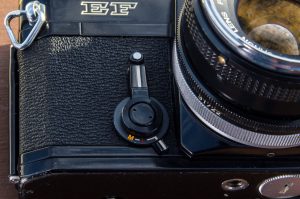
This Multi Purpose lever is directly below the much larger self-timer lever and has 3 positions, left, center, and right (when looking at the front of the camera).
- The first position on the left has an orange “M” which activates the mirror lock. Upon moving the lever into this position, the reflex mirror will raise, blocking the viewfinder, and stay in that position until the lever is moved away from the “M” position. This is useful for macro or astrophotography to avoid any type of vibration caused by movement of the reflex mirror.
- If you want to stop down the lens iris to your chosen aperture for a depth of field preview, simply press the self timer lever towards the lens. Doing this will only momentarily stop down the lens’s iris to your chosen aperture setting. If however, you want to lock the lens in this stopped down position, move the multi-purpose lever to the middle position which has a red “L”. This will lock the lens in stopped down mode for use in situations where you need to see a depth of field in the viewfinder.
- The right position has no letter, and is the default position for the multi-purpose lever. When it is in this position, the self-timer can be used without locking the depth of field preview, or the mirror in the up position.
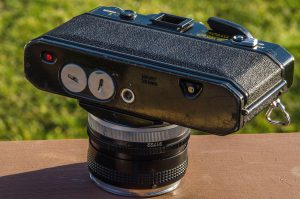
On the bottom plate of the camera is a standard tripod socket, the rewind release button, two battery compartments for each battery, and a red battery check button. Although my Canon EF seemed to be in good working order, for whatever reason, this battery check feature did not work even with good batteries. Another thing regarding the batteries which I see often repeated on the Internet comes from the Canon EF’s Wikipedia article where it says that the EF works with “common 1.5 volt batteries without modification to the internal electronics.” This is somewhat misleading as the camera was not actually designed for 1.5v silver oxide or alkaline batteries. It was intended to be used with 1.35v mercury batteries that were common at the time.
What the Wikipedia article is likely referring to is that the Copal Square shutter has a stepping circuit which allows it to work with 1.5v batteries without damaging or altering the metering characteristics of the camera. Many cameras, like the original F-1 and the entire Canon FT series were originally designed for 1.35v mercury batteries, and will return incorrect readings from the meter when used with higher voltage batteries. This means, that other than the “new” F-1, the Canon EF is the only large bodied Canon SLR that works reliably with modern 1.5v batteries without altering the meter or the shutter speeds.
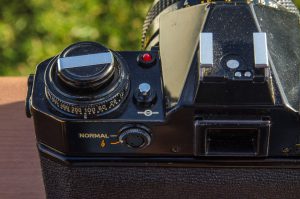
The left side of the top plate has a traditional rewind knob, the ASA film speed selector, the battery test light, and an AE lock button. The AE lock button is used to hold a metered exposure setting while allowing a photographer to recompose their image. This is useful when you want to take a meter reading of something off center in the viewfinder to intentionally over or under expose a part of the image. While the AE lock feature would become a standard function on many AE cameras that would follow, the implementation of this button is a bit awkward as the button is not in a conveniently located spot for a photographer to naturally reach. Still, the inclusion of this feature must have seen like a pretty cool feature back in 1973.
Beneath the AE lock button, to the left of the viewfinder on the back of the camera is a flash mode selector. The two modes are “Normal” and a lightning bolt which signifies a primitive “smart” flash system which required the use of the Canon Speedlite 133D which was made specifically for this camera. This mode was called the CAT (Canon Auto Tuning) mode and would utilize the focused distance of your subject and a measurement of the flash’s batteries to both set an appropriate aperture f/stop and calculate a properly timed flash. With any other hot shoe electronic flash or a flash using the PC sync cord, this switch should be set to “Normal” and both shutter timings and aperture f/stops must be set manually.
The Canon EF is a very well equipped and modern camera that holds up extremely well today. It’s high combination of build quality and features makes it an extremely capable film camera, despite being over 40 years old. I will admit to never really falling in love with too many Canon SLRs, but this camera is the exception. I found the build quality and layout of the controls to be excellent. I adore the large shutter speed dial and found it’s overlapping positioning on the front of the camera to be extremely easy to use. The combination of being able to see selected aperture and shutter speeds in the viewfinder and this incredibly easy to use shutter dial, eliminates almost all of my complaints about using Shutter Priority AE. I simply cannot understand why Canon did not continue this design on later cameras like the AE-1 and it’s variants.
As I write this, I haven’t yet seen the results from my inaugural roll of film, but I already feel like declaring that not only is the Canon EF as the best Canon SLR I’ve ever used, but I can also say it is one of the best SLRs made by any company, ever.
My Results
The Canon EF accompanied me on a trip to my in-laws in January, 2017 alongside the Vitomatic IIa which I reviewed yesterday. Unlike that review though where I used expired Fuji Neopan, I tried my hand at expired Ferrania 200 film that came highly regarded by my friend Adam Paul over at quirkyguywithacamera. Ferrania is a very flexible film with a warm cast to it’s images giving just enough of a unique look to be interesting, without over “lomogra-fying” the image.
I was prepared for unexpected color casts from my images, but had hoped that the meter on the Canon EF would handle the film well. Per Adam’s recommendation, I shot the film at box speed, even though it had been expired since 2006.
Usually when I take out a camera for the first time, I conservatively shoot it at predictable speeds, between f/5.6 and f/11 without taking too many risks until I can see how the camera performs. The Canon EF was such a confidence inspiring camera, that I chose to shoot it in ways I don’t normally shoot a camera for the first time. Wide open in a grocery store, in a basement with only a single window light, in high contrast situations, and in bright sunlight. I tried it all, but would I live to regret my decision?
It would seem my risk paid off as I got an entire roll of wonderful shots from the Canon EF. Not only did the Ferrania produce pleasantly warm shots as Adam said it would, but the Canon’s meter handled the expired film in a variety of lighting conditions masterfully. This is especially impressive considering the age of the camera and that it was originally designed for 1.35v mercury batteries. It is very reasonable to think that after 4 decades, a light meter would eventually start to lose sensitivity. I have no way of knowing how many other Canon EFs out there have a good meter like mine, so either I’m just incredibly lucky, or the meter in the EF is just that good. My instinct is to say it’s the latter.
In terms of image quality, Canon’s FD mount lenses are as good as anything out there. The images taken with this camera are likely to look as good as those shot through a Nikkor, Rokkor, Takumar, or any other number of established Japanese SLRs lens families. The best attributes of the EF are it’s near perfect balance, excellent viewfinder, and excellent auto exposure system
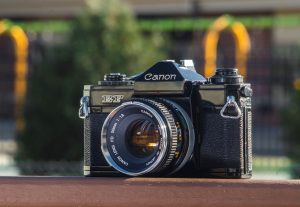
If you were to put a gun to my head and force me to pick something I don’t like about the camera, it would have to be the dual PX625 battery compartments. The EF’s most logical competitor is the Nikomat ELW which uses a single 6v PX28 battery. Not only is a single PX28 battery cheaper and easier to come by than two PX625 batteries, but it’s nicer dealing with a single battery compartment as opposed to two. A very minor nitpick this is, but the fact that it’s the only thing I could come up with, speaks to how good the Canon EF is.
I said it earlier in the review, but I’ll say it again, the Canon EF is my favorite Canon SLR of any I’ve used, and one of my favorite of any brand. It puzzles me to no end why Canon designed the shutter priority system in this camera in such a way that worked so well, yet they never repeated it with any other model. Reading this review without handling the camera yourself, it might seem like a far stretch that the positioning of the shutter speed selector could make such a difference, but it does. That combined with the full information viewfinder and the excellent meter and professional level build quality make for an extremely capable and fun camera. I wish my EF was a later version with the split image focus aide in the viewfinder, but even without it, I had no issue obtaining accurate focus.
I don’t own a Canon F-1 and know they are highly regarded as the most desirable of all FD mount Canon SLRs, but as long as you can live without an interchangeable viewfinder, or lack of a motor drive connection, the Canon EF represents one hell of a great bargain. When this camera was new, it cost the equivalent of nearly $2000 today. For that kind of cash now, you are well into pro level DSLR category.
My Final WordHow these ratings work |
The Canon EF was Canon’s first interchangeable lens SLR with in-body shutter priority auto exposure. It was built to an extremely high standard, comparable to Canon’s professional F-1 series, but with a Copal Square metal blade shutter. In my opinion, it had the best implementation of shutter priority AE of any Canon camera, and coupled with excellent ergonomics, a full information viewfinder, tons of features, an excellent meter, and Canon’s excellent FL/FD lens mount, is an extremely capable camera. It is my favorite Canon SLR, and one of the best SLRs by any brand I have ever used. This is a wonderful camera, and one I highly encourage who might be interested in film photography to consider. | ||||||
| Images | Handling | Features | Viewfinder | Feel & Beauty | History | Age | |
| 2 | 2 | 2 | 2 | 2 | 1 | 0% | |
| Bonus | +1 for outstanding design and usability, the complete package | ||||||
| Final Score | 12.0 | ||||||
Additional Resources
http://global.canon/en/c-museum/product/film88.html
https://en.wikipedia.org/wiki/Canon_EF_camera
http://camerapedia.wikia.com/wiki/Canon_EF
https://guaromekano.wordpress.com/2015/02/17/canon-ef-film-camera-and-my-most-expensive-photograph/
http://www.collection-appareils.fr/x/html/page_standard.php?id_appareil=10509 (in French)
http://www.canonclassics.com/canon-ef/20-4/
http://mikegrigsby.com/html/canon_ef.html (archived)

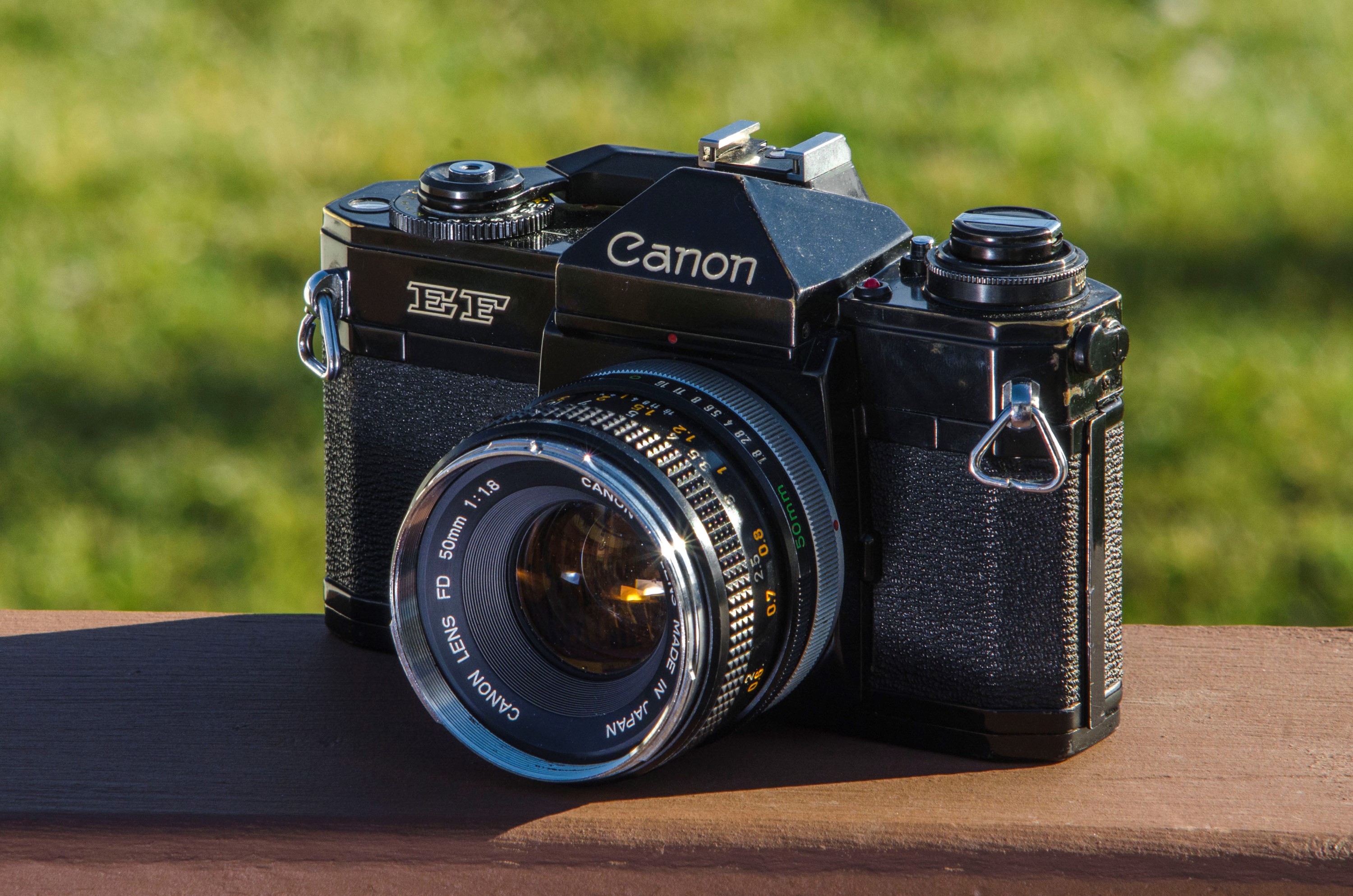
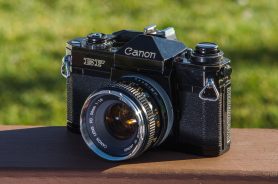
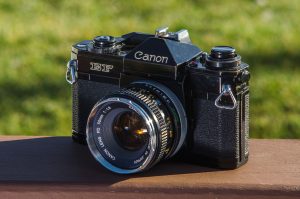











Hi Mike,
Another good review. I wanted to like this camera but have never seen a working unit. If you would like a couple of free parts cameras with the split prisms let me know.
Best regards,
Jonathon Campo
Great review Mike. The Canon history was really interesting. I have an early 1950s Canon IV SB that is marked for military base exchange sales. I haven’t ever shot anything with it but it is really well built lika a Leica. I also really like the Canon digital cameras. Keep up the good work. Jeff Oliveira in CA.
Great review, and interesting section on Canon’s history – a lot there that I didn’t know. I’m lucky enough to have a near-mint EF, and I agree completely about the implementation of shutter priority – not normally my preferred mode, but Canon got it right with this camera.
Great review, thank you. I have several working EF’s, I really like old Canons and this model in particular. Serial numbers begin with 120, 213, 299 and 407. Only the 407 has the split image rangefinder, the 299 does not. If you find such esoteric info interesting!
That is interesting and disproves the source in the photo.net link I mention in my review that suggested the change was made around 280xxx. Perhaps there was a period where the factory used a mish-mash of whatever parts they had lying around! 🙂 I love my EF, but would want one with a split image someday.
Since the serial number was stamped or engraved in the top plate during manufacture I assume that cameras were assembled from batches of finished parts. It may be that there is no definitive serial number where the change was made, high numbers could have been shipped and sold before lower numbers to some degree. The EF has such a generous and bright viewfinder, it’s a pleasure to frame and focus even without the split image rangefinder. Much nicer than Nikkormats of the era in my opinion.
Again, thank you for your very thorough and comprehensive assessment. I very much enjoyed the magazine ad showing original list prices. My main criticism is the on/off switch, which is klunky and too easy to turn on accidentally. And those blasted mercury batteries, although the alkaline versions work fine.
Great review! I have an EF and I’m loving it. Mine has a split prism and 400+ number. This camera is my first manual focus camera. It is so easy to pick up and feel comfortable shooting. I’m burning through a few rolls of Fuji Superia 200 to get a feel for it. I got the EF for $67 in fantastic condition, a FDn 50mm 1.4 for $30, light seals from USCamera for $10, and a box of Fuji Superia 200 for $11. Low enrty cost into an AWESOME vintage SLR and the FD system.
Just found this excellent website because of the article on Tri-X 🙂
I own two Canon EF’s serial numbers starting with 208 and 288 and both don’t have the split image screen. I love the shutter priority especially with tele lenses. I go my first one with a Vivitar series 1 135mm back in 1975(?) and it is still a nice combination although I have to admit that I use my AE1 more often because it is lighter weight.
I’ve always been curious about the EF. I had an original F1 a few years ago and it didn’t work that well. The meter was goosed. Plus, I really like the fact these cameras go for similar prices to the FTb. I like both. Loved your in depth review. I’m going to hunt myself an EF as I was hunting fir an FTb, byt you swayed my choice. Fab articles! Dave Sharp
Thanks for the compliment David. You’re right the EF does tend to go for about the same (sometimes less) than the FTb. For whatever reason, it’s never caught on quite like the F-1, but having shot both, I actually prefer the EF over the F-1.
Excellent read Mike. I’m about to sell my EF but was wondering why you prefer it to the F1. I prefer the F1 but have to agree with you that the EF has some very interesting features.
Very nice review, I enjoyed reading. The “Black Beauty” was my first camera, a special gift from my parents, with the 50mm/f1.4 SSC lens. I later added a 28mm/f2.0 lens, but life was simple back then. After a decade of amateur use, I started using other brands (Pentax ME, early Minolta autofocus, then Canon Rebel XS and Canon DSLR, and now Sony up to the A1), but have kept my trusty camera which has taken many memorable photos. Then around 20 years ago, I went off the nostalgic deep end. As everybody was dumping film cameras and stores were selling “new old stock”, I started collecting Canon EF’s, new or unused in boxes, and some of the best nFD lenses to go with them. They don’t build them like this anymore…
The Canon EF’s are truly nice cameras and to this day, remain my favorite Canon SLRs! Youre right, they don’t make them like this anymore. If you ever end up selling some of the ones you’ve collected, keep me in mind!
One of the all time under-appreciated models. My experience is, it presents rock-solid Canon reliability with a metering system unique to anything anybody has put on the market. Had they featured a removable VF I would probably never use my original F1 again. While the old wisdom about the camera being simply a box to support the use of the lens generally does apply, the EF metering makes it a box unlike any other. And……of no small consequence, at least for me anyway, shutter activation on the EF does not include that annoying metallic ring of the F1.
It is quite the battery burner.
Hi Mike,
This is one of the best review of the Canon EF that I have come across on the Whole Wide World network. I am the proud owner of about 5 Canon EFs, six new F1s, one F1N, Nikons, Minoltas and a many other brands. However, in all the reviews that I read there is one feature in the Canon EF that nobody seems to mention.
The feature is that for EVERY exposure from 1000th of a second to 30 seconds, the MIRROR LOCKS UP FIRST as soon as the SHUTTER BUTTON is tripped. Unlike other SLR cameras where the mirror goes up just before the shutter opens. The result of this feature is a reduction in camera shake for medium to long exposures without having to manually lock up the mirror before taking the picture.
Having used used other cameras, I am not aware of any with this feature, but I wish Canon had implemented it in the new F1, then the question about not having mirror lock up wouldn’t be asked.
Thank you,
Frederick, thank you for the kind words! I agree with your praise for the EF as it remains my all time favorite Canon SLR after all these years. Your comment about the mirror locking up before each shot is something I’ve heard before. I definitely know there is at least one other SLR that has a feature like that, but I cannot recall what it is! I’ve done so much research on so many different cameras, I cannot remember them all! Anyway, glad to hear you liked the review. I would like to test a Canon New F-1 one day. I have an original F-1, but it’s in very poor condition.